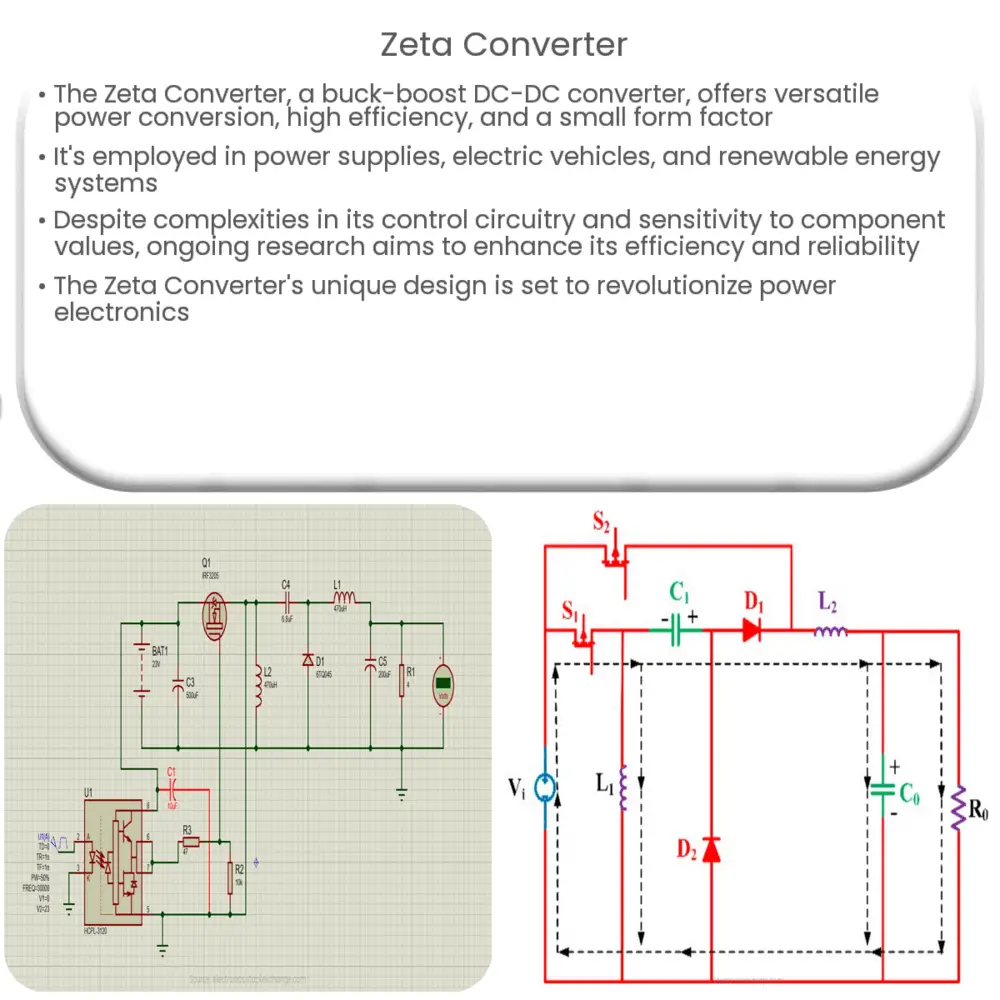The Zeta Converter is a versatile, non-isolated DC-DC converter for efficient voltage regulation, offering continuous input/output currents and reduced EMI.

Zeta Converter: Revolutionizing Power Conversion Technology
Introduction
In the realm of power electronics, efficient and reliable power conversion is crucial for the optimal performance of various electronic devices. The Zeta Converter, a prominent member of the DC-DC converter family, is an emerging solution that caters to these needs. In this article, we will delve into the key features, applications, and advantages of this innovative converter.
Understanding the Zeta Converter
The Zeta Converter, also known as the Ćuk-derived converter, is a non-isolated, buck-boost type DC-DC converter. It is capable of regulating output voltage, regardless of whether it is higher or lower than the input voltage. This unique ability sets it apart from traditional buck or boost converters, which can only handle either step-up or step-down voltage conversions.
In essence, the Zeta Converter is a hybrid topology that combines elements of both buck and boost converters. It uses an inductor, capacitor, diode, and switch to manage energy transfer and regulate output voltage. The converter’s name is derived from its inventor, Dr. Slobodan Ćuk, who first introduced the concept in 1981.
Key Features
Among its many features, the Zeta Converter boasts the following attributes:
- Flexible Voltage Conversion: The Zeta Converter can operate in both step-up and step-down modes, making it highly versatile for various applications.
- Continuous Input and Output Currents: The converter’s inductor-capacitor (LC) network ensures smooth and continuous input and output currents, minimizing input ripple current and electromagnetic interference (EMI).
- High Efficiency: The Zeta Converter’s unique topology enables high efficiency, reducing energy loss and heat generation during power conversion.
- Small Form Factor: The Zeta Converter’s design allows for compact implementation, making it suitable for applications with space constraints.
Applications
Given its versatile and efficient nature, the Zeta Converter finds applications in a wide array of industries, including:
- Power Supply Units: The Zeta Converter can be employed in power supplies for computers, telecommunications equipment, and other electronics, where a stable and regulated output voltage is essential.
- Automotive: In electric and hybrid vehicles, the Zeta Converter can be used to manage power distribution, ensuring optimal performance and energy efficiency.
- Renewable Energy: The converter can be integrated into solar power systems, where it can effectively manage the variable input voltage from solar panels and provide a stable output for battery charging or grid-tied applications.
Advantages of the Zeta Converter
There are several benefits to using a Zeta Converter in comparison to traditional buck or boost converters. These advantages include:
- Improved Efficiency: The Zeta Converter’s unique design reduces energy losses, resulting in higher overall efficiency. This advantage is especially beneficial in applications where energy conservation is a priority, such as in renewable energy systems or electric vehicles.
- Better Thermal Management: With reduced heat generation, the Zeta Converter requires less cooling, thereby minimizing thermal stress on components and increasing their longevity.
- Lower Electromagnetic Interference (EMI): The continuous input and output currents of the Zeta Converter reduce EMI, making it an ideal choice for applications that demand minimal interference, such as sensitive electronic equipment or medical devices.
- Compact Design: The small form factor of the Zeta Converter allows it to fit into space-constrained applications, enabling more efficient use of available space in the design of electronic devices and systems.
Challenges and Future Developments
While the Zeta Converter offers numerous advantages, there are still some challenges to overcome. One notable challenge is the complexity of its control circuitry, which can make the design and implementation process more difficult. Additionally, the Zeta Converter’s performance may be susceptible to variations in component values, requiring tight tolerances and high-quality components to maintain optimal performance.
Future developments in the field of Zeta Converters aim to address these challenges by focusing on simplifying the control circuitry, improving component tolerances, and developing new topologies that further enhance efficiency and reliability. Research is also being conducted to explore the potential of integrating Zeta Converters with other power conversion technologies, such as resonant converters and digital power management systems, to create even more versatile and efficient solutions.
Conclusion
In conclusion, the Zeta Converter is a highly versatile and efficient power conversion technology that holds significant promise for various industries, including power supply units, automotive, and renewable energy systems. Its unique topology enables it to step-up and step-down voltage while maintaining continuous input and output currents, resulting in reduced EMI and improved overall efficiency. While there are challenges to address, ongoing research and development efforts are paving the way for even more advanced and efficient Zeta Converter solutions, which will undoubtedly revolutionize the field of power electronics in the years to come.

